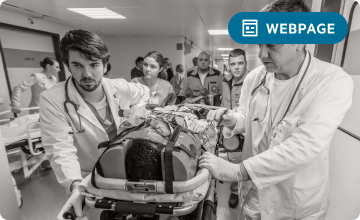HEMORRHAGE CONTROL REQUIRES ALL HANDS ON DECK
Dosage
Pre-pooled INTERCEPT® Fibrinogen Complex facilitates transfusion of high doses of fibrinogen from a single container.
Fibrinogen decreases rapidly and significantly in hemorrhage across a variety of clinical settings.1,2
These clinical settings include:
- Cardiovascular surgery3,4
- Hemorrhagic trauma2
- Obstetric hemorrhage5
- Organ transplant6
- Disseminated intravascular coagulation (DIC)7
INTERCEPT Fibrinogen Complex retains in vitro functional characteristics 5 days post-thaw8 and pre-pooling facilitates transfusion of high doses of fibrinogen from a single container.*
See the Circular of Information for blood component dosing information9
| INTERCEPT FIBRINOGEN COMPLEX | # DONORS† | MEAN (SD) FIBRINOGEN CONTENT AT THAW (mg) | MEAN (SD) FIBRINOGEN CONTENT AT THE END OF 5 DAYS POST THAW (mg) |
|
FC10 |
2 | 740 (166) | 686 (165) |
|
FC15 |
4 | 1556 (248) | 1435 (206) |
|
FC20 |
6 | 2,220# | 2,058# |
|
FC30 |
8 | 2845 (618) | 2625 (562) |
|
FC40 |
10 | 3,700# | 3,430# |
Mean (±Standard Deviation) from Pathogen Reduced Cryoprecipitated Fibrinogen Complex prepared from whole blood-derived plasma frozen within 24 hours after phlebotomy (PF24) plasma.
†Number of donors based on whole blood donors
#Calculated based on pooling of FC10, SD not available
No in vivo clinical studies have been performed with INTERCEPT Fibrinogen Complex
You may also be interested in
*Pooling facilitates transfusion of high doses of fibrinogen from a single container. Fibrinogen content of INTERCEPT Fibrinogen Complex depends on donor plasma fibrinogen levels.
References:
- Hiippala ST, Myllyla GJ, Vahtera EM. Hemostatic factors and replacement of major blood loss with plasma-poor red cell concentrates. Anesthesia and analgesia 1995;81:360-5.
- Rourke C, Curry N, Khan S, et al. Fibrinogen levels during trauma hemorrhage, response to replacement therapy, and association with patient outcomes. Journal of thrombosis and haemostasis. JTH 2012;10:1342-51.
- Ranucci M, Pistuddi V, Baryshnikova E, Colella D, Bianchi P. Fibrinogen Levels After Cardiac Surgical Procedures: Association With Postoperative Bleeding, Trigger Values, and Target Values. Ann Thorac Surg 2016;102:78-85.
- Karkouti K, Callum J, Crowther MA, et al. The relationship between fibrinogen levels after cardiopulmonary bypass and large volume red cell transfusion in cardiac surgery: an observational study. Anesthesia and analgesia 2013;117:14-22.
- Gillissen A, van den Akker T, Caram-Deelder C, et al. Coagulation parameters during the course of severe postpartum hemorrhage: a nationwide retrospective cohort study. Blood advances 2018;2:2433-42.
- Abuelkasem E, Tanaka KA, Planinsic RM. Recent update on coagulation management and hemostatic therapies in liver transplantation. Minerva anestesiologica 2018;84:1070-80.
- Seligsohn U. Disseminated Intravascular Coagulation. In: Beutler E, Coller BS, Lichtman MA, Kipps TJ, Seligsohn U, eds. Williams Hematology. 6th ed. New York: McGraw Hill; 2001:1677-95.
- INTERCEPT Blood System for Cryoprecipitation for the manufacturing of Pathogen Reduced Cryoprecipitated Fibrinogen Complex Package Insert.
- AABB. Circular of Information for the Use of Human Blood and Blood Components. Bethesda, MD: AABB; 2024.


